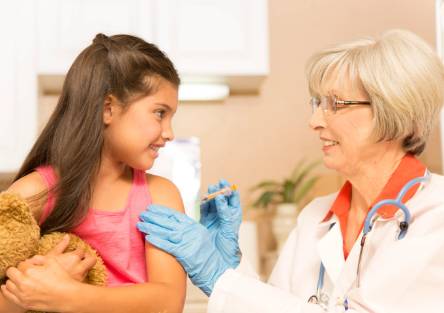Is Your Child at Risk for Pneumonia?

By Alberto Carranza, MD
Co-Authored by Ruchi Kaushik, MD, MPH
Winter (and the holidays!) are upon us, a time when families come together to eat, laugh, love, and, unfortunately, share germs. Most illnesses resolve quickly and easily on their own.
Some children, however, will develop pneumonia this season. World Pneumonia Day is November 12 and below are a few tips for parents to recognize the signs of pneumonia and know when to seek medical care right away.
What is pneumonia?
Pneumonia is an infection of one or both lungs. The infection causes the lungs to fill with fluid or pus and results in cough with phlegm, fever, and changes in breathing. These changes can be fast breathing, having to work harder to breathe, or shortness of breath. Other symptoms include chest pain, abdominal pain, nausea or vomiting, decreased appetite or intake of fluids, and fatigue.
If your child is experiencing any of these symptoms, you should seek medical care immediately.
How is pneumonia diagnosed?
Your pediatrician or the urgent care/emergency department physician can diagnose pneumonia based on the symptoms and the sounds he/she hears when listening to your child’s lungs. If there is a question about having pneumonia, your doctor may order a chest X-ray, but it is not always necessary. In sicker children, sometimes blood work will also be obtained.
How is pneumonia treated?
There are three common types of pneumonia and treatment depends upon the type.
- Viral: Children are exposed to viruses frequently and viruses can cause pneumonia. Viral pneumonia cannot be treated with antibiotics. Treatment is supportive and includes oxygen as needed, intravenous or nasogastric tube (a soft, flexible tube from your child’s nose to stomach) fluids in children who are vomiting or not drinking enough, and watchful waiting. Some examples are flu and RSV.
- Bacterial: Most children with bacterial pneumonia can be treated with antibiotics at home. However, sometimes they may also need oxygen, intravenous fluids, and intravenous antibiotics if they are sicker.
- Atypical or “walking” pneumonia: “Walking” pneumonia is more common in school-aged children and is so named because the illness is often not severe. It can be treated with an antibiotic.
Other, less common, types of pneumonia are fungal, aspiration, hospital-acquired, and chemical. These can be related to an individual’s environment, underlying chronic medical problems, and exposures resulting in sicker children who require hospitalization.
How is pneumonia prevented?
Pneumonia can be prevented by:
- Vaccinate: Prevnar, a vaccine against the most common cause of pneumonia, is offered with all typical vaccines at your regular pediatrician check-ups. The flu vaccine can also help prevent pneumonia, as pneumonia is a common complication of the flu. Some children with medical problems may also be offered a special pneumonia vaccine after two years of age.
- Wash your hands frequently
- Protect your child from exposure to cigarette smoke
If your child is experiencing any of the above symptoms, contact your pediatrician immediately or visit one of our three emergency departments in San Antonio.
If you need a pediatrician, visit this page.
